By: Ashish Kumar Mehta | Comments (4) | Related: > Upgrades and Migrations
Problem
The company where I work is planning to install SQL Server 2008 Service Pack 1 (SP1). I have heard that the installation process for SQL Server 2008 Service Pack is different from previous SQL Server Editions. How much different is the installation process? In this tip, we will review the SQL Server 2008 Service Pack installation process, which differs quite a bit from SQL Server 2000 and SQL Server 2005 installations.
Solution
It is recommended that before applying any service pack on SQL Server, database administrators should take a full backup of all the user and system databases including the Resource database which was first introduced in SQL Server 2005. The Resource database is a read-only database that contains all the system objects that are included with SQL Server.
Database Administrators should read the readme.txt file which comes with Service Pack Installation before applying the Service Pack. However, Database Administrators should first apply the service pack on development and test servers before applying on production servers. If there are no issues reported in the development and test Environments after testing your applications, then you can apply them on the production servers. Here are the essential steps that can make your SQL Server 2008 Service Pack (SP1) installation as smooth as possible:
- Download SQL Server 2008 SP1.
- Development environments:
- Issue a full backup of all user and system databases including the Resource database.
- Take note of all the Startup parameters, Memory Usage, CPU Usage etc.
- Install the service pack on development SQL Servers.
- Create a backup and restore plan with the steps for "What to do if application is not working properly after installing the new Service Pack?"
- Test environments:
- Issue a full backup of all user and system databases including the Resource database.
- Take note of all the Startup parameters, Memory Usage, CPU Usage etc
- Install the service pack on test SQL Servers.
- Conduct testing for administrative process as well as coordinate testing with the Development and QA Teams to ensure the application is performing as expected.
- Test the rollback plan.
- Production environments:
- Plan for a scheduled downtime on the Production Servers as it takes approximately 30 minutes to apply the service pack on SQL Server 2008.
- Issue a full backup of all user and system databases including the Resource database.
- Take note of all the Startup parameters, Memory Usage, CPU Usage etc
- Install the service pack on test SQL Servers.
- Validate the application is working properly.
Steps to Install SQL Server 2008 Service Pack 1 (SP1)
1. Download SQL Server 2008 Service Pack 1 (SP1) from the following
link.
2. Double Click Setup.exe to extract the Service
Pack installation files from the setup.
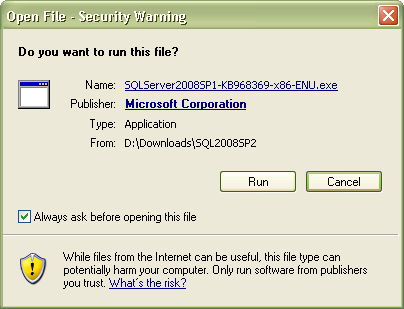
3. Once setup files are extracted go to the folder where the files are extracted and click Setup.exe. This will open up SQL Server 2008 Service Pack 1 screen as shown in the snippet below. In the Welcome screen the SQL Server 2008 Setup program will check for few rules before applying the Service Packs. If any of the rules are failing, the installation will not continue further. Hence, you need to fix those issues before continuing with the installation.
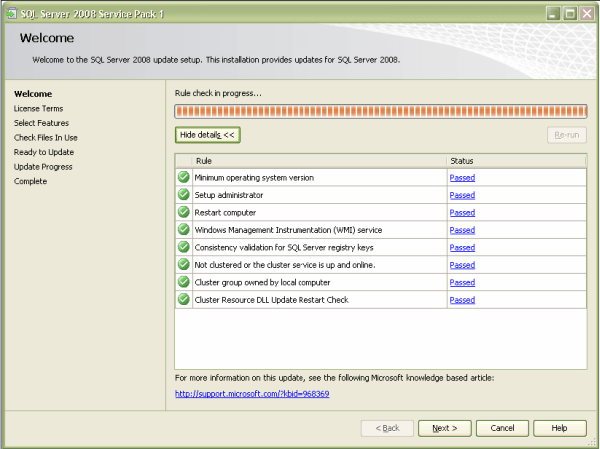
4. In License Terms screen, read the license agreement and then select the check box at the bottom of the page to accept the licensing terms and conditions of the product. Click Next to continue with the installation.
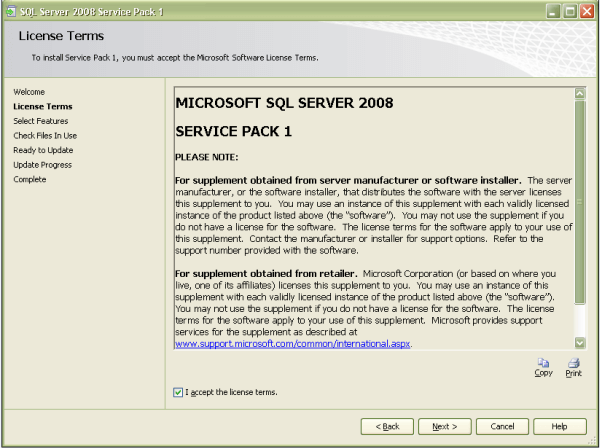
5. In Select Features screen, select the SQL Server Instance and select the features of SQL Server 2008 which need to be upgraded. A brief description about each feature is shown in the right side panel along with the Language, Edition, Patch Level, Architecture, Service Pack and Upgrade Status when each of the features is selected. The different components which are available for upgrade within SQL Server 2008 are mentioned below:
- Database Engine Services
- SQL Server Replication
- Full-Text Replication
- Analysis Services
- Reporting Services
- Shared Features
- Business Intelligence Development Studio
- Client Tools Connectivity
- Integration Services
- Client Tools Backwards Compatibility
- Client Tools SDK
- SQL Server Books Online
- Management Tools - Basic
- Management Tools - Complete
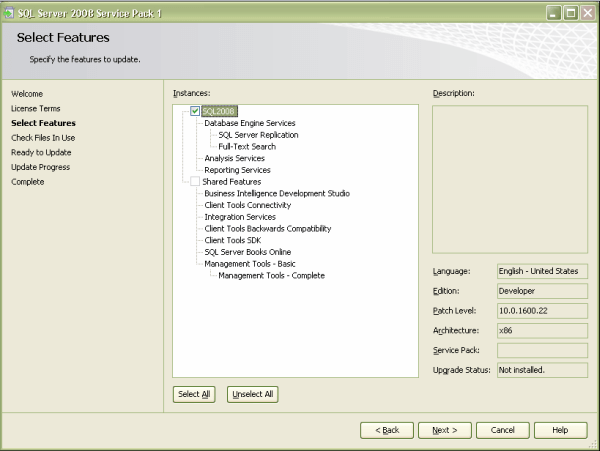
Once all the features are selected click Next to continue with the SQL Server 2008 Service Pack 1 (SP1) installation.
6. In Check Files In Use screen the setup will check for SQL Server related files which are currently being used. If there are any such files then they need to be released before performing the Service Pack installation. Click Next to continue with the installation.
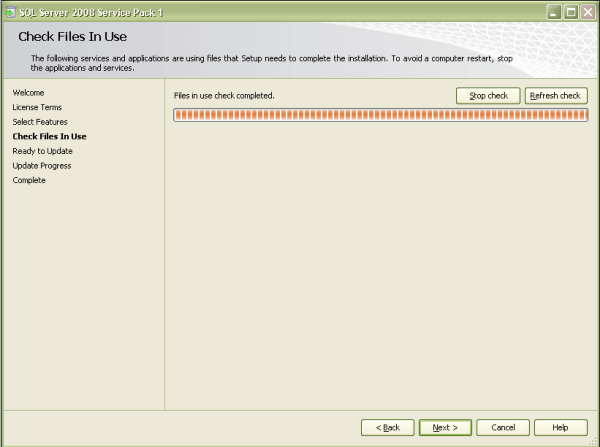
7. In Ready to Upgrade screen you can verify the list of features which will be upgraded during the installation. If you are fine with the list of features, then click Upgrade to perform the actual Service Pack installation.
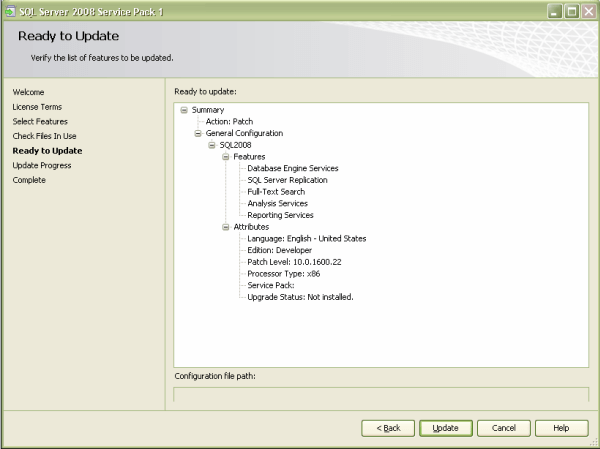
8. In Upgrade Progress screen you will be able to see the installation progress. It will approximately take 30 minutes to complete the installation. The installation time varies depending upon the hardware configuration.
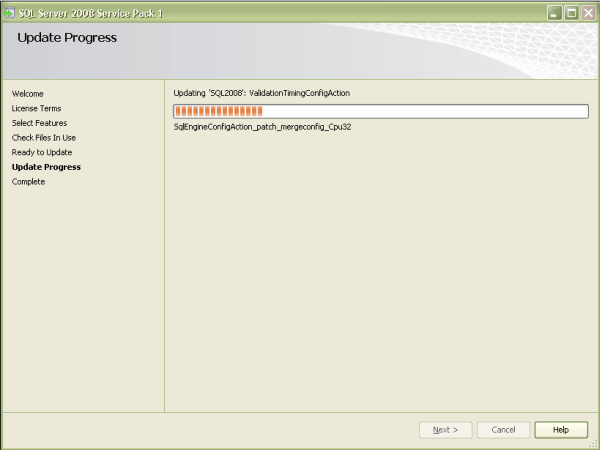
9. Once the Service Pack installation is successful you will be able to see the Success message as shown in the snippet below.
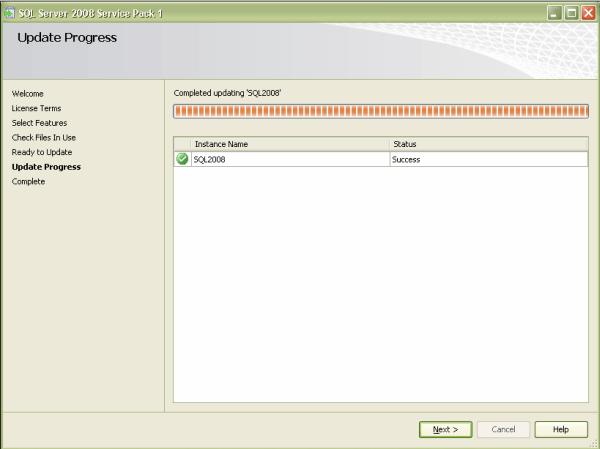
10. On the Complete screen you will be able to see "Your SQL Server 2008 update operation has completed successfully" message. Click Close to end the installation setup.
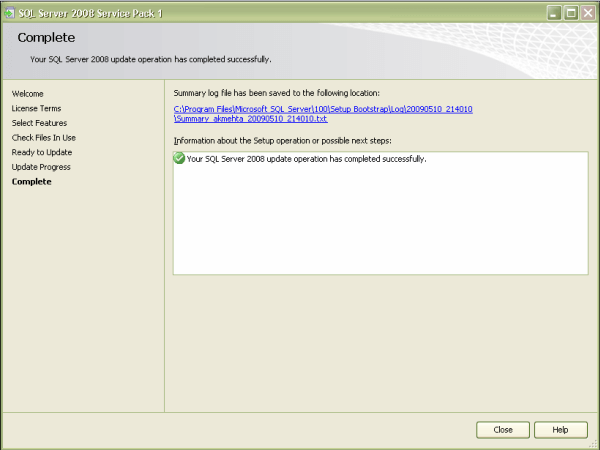
11. You can verify the SQL Server 2008 Service Pack 1 (SP1) installation by executing the query below in SQL Server Management Studio (SSMS).
SELECT
SERVERPROPERTY('Edition') AS 'Edition',
SERVERPROPERTY('ProductVersion') AS 'ProductVersion',
SERVERPROPERTY('ProductLevel') AS 'ProductLevel',
SERVERPROPERTY('ResourceLastUpdateDateTime') AS 'ResourceLastUpdateDateTime',
SERVERPROPERTY('ResourceVersion') AS 'ResourceVersion'
GO

Next Steps
- Download SQL Server 2008 Enterprise 180 Day evaluation from this site
- Identify which SQL Server version you are currently running from this tip
- Download SQL Server 2008 Service Pack 1 from this site
- List of the bugs that are fixed in SQL Server 2008 Service Pack 1
About the author
 Ashish Kumar Mehta has been contributing to the MSSQLTips.com community since 2009 with over 60 tips.
Ashish Kumar Mehta has been contributing to the MSSQLTips.com community since 2009 with over 60 tips.This author pledges the content of this article is based on professional experience and not AI generated.
View all my tips






